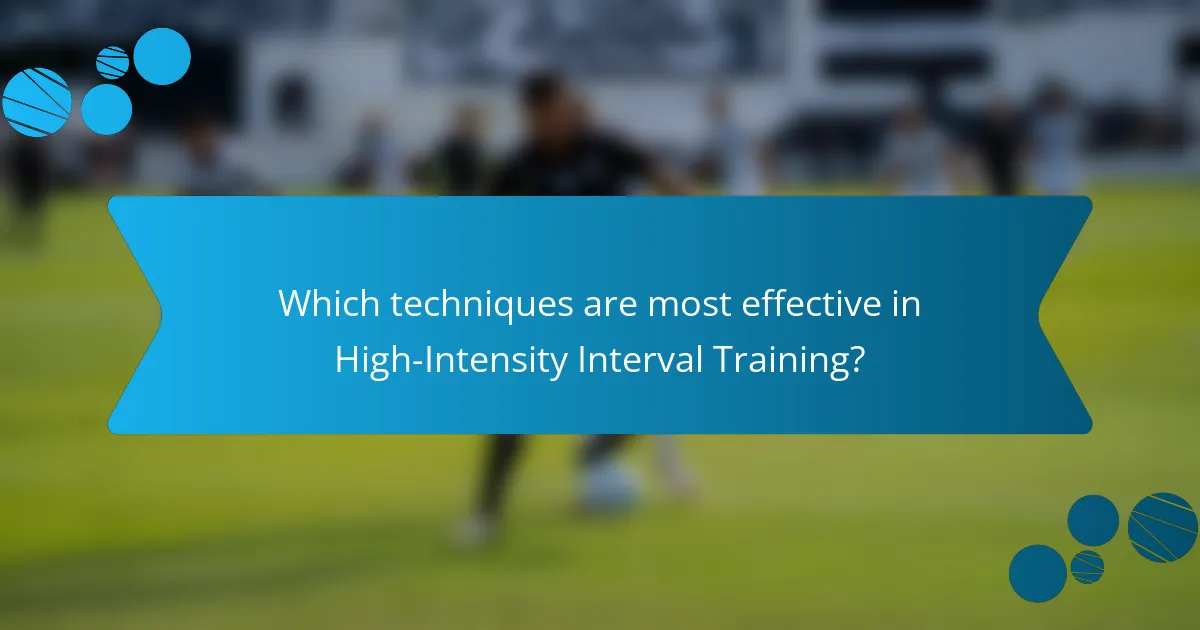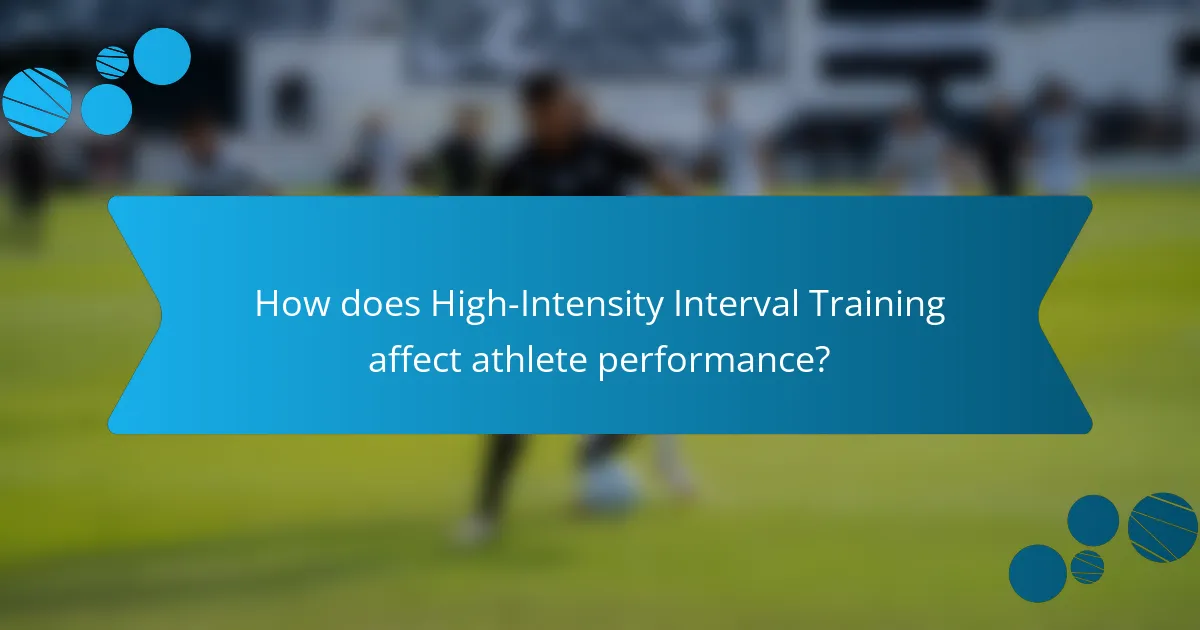High-Intensity Interval Training (HIIT) offers significant benefits like improved cardiovascular health and enhanced athletic performance. This article explores effective HIIT techniques, their impact on athlete performance, and common challenges faced during training. Discover how varied workout intervals and proper recovery can maximize results while addressing the unique attributes of different HIIT programs.

What are the key benefits of High-Intensity Interval Training?
High-Intensity Interval Training (HIIT) offers numerous benefits, including improved cardiovascular health, increased metabolic rate, and enhanced athletic performance. This training method boosts endurance and facilitates faster fat loss compared to traditional steady-state workouts. Research indicates that HIIT can lead to significant improvements in aerobic and anaerobic fitness levels, making it an efficient choice for athletes. Additionally, HIIT workouts can be completed in shorter durations, providing time efficiency while maximizing results.
How does HIIT improve cardiovascular health?
High-Intensity Interval Training (HIIT) significantly enhances cardiovascular health by improving heart efficiency and increasing aerobic capacity. Studies show that HIIT can lead to a 15% increase in VO2 max, a key indicator of cardiovascular fitness. This training method promotes better blood circulation and reduces resting heart rate, contributing to overall heart health. Additionally, HIIT can lower blood pressure and improve cholesterol levels, further reducing the risk of heart disease.
What role does HIIT play in weight management?
High-Intensity Interval Training (HIIT) is effective for weight management by increasing calorie burn and boosting metabolism. It combines short bursts of intense exercise with rest periods, leading to greater fat loss compared to steady-state cardio. Studies show that HIIT can burn 25-30% more calories than traditional exercise in the same amount of time. Additionally, HIIT promotes muscle retention, which is crucial for maintaining a healthy weight. The unique attribute of HIIT is its time efficiency, making it accessible for those with busy schedules.
How can HIIT enhance metabolic rate?
High-Intensity Interval Training (HIIT) significantly enhances metabolic rate through intense bursts of activity followed by rest. This approach increases calorie burn during and after workouts due to excess post-exercise oxygen consumption (EPOC). Research shows that HIIT can elevate metabolic rate by 6 to 15 percent for hours post-exercise. Additionally, it promotes muscle retention, which is crucial for maintaining a higher resting metabolic rate. HIIT’s efficiency allows athletes to maximize performance benefits within shorter training sessions, making it a preferred method for enhancing overall fitness and metabolic health.
What psychological benefits are associated with HIIT?
High-Intensity Interval Training (HIIT) enhances psychological well-being by reducing anxiety, improving mood, and boosting self-esteem. Research shows that HIIT can increase endorphin levels, leading to a sense of euphoria post-workout. Additionally, the structured nature of HIIT fosters discipline and resilience, contributing to improved mental health. Regular participation in HIIT has also been linked to better stress management and increased motivation, making it a valuable tool for mental fitness.

Which techniques are most effective in High-Intensity Interval Training?
High-Intensity Interval Training (HIIT) techniques like Tabata, Sprint Intervals, and Circuit Training are highly effective. These methods enhance cardiovascular fitness, improve metabolism, and increase athletic performance.
Tabata involves 20 seconds of all-out effort followed by 10 seconds of rest for eight rounds. Sprint Intervals consist of short bursts of maximum effort followed by longer recovery periods. Circuit Training combines strength and cardio exercises in a sequence, maximizing calorie burn and endurance.
Research indicates that HIIT can improve VO2 max significantly, which is crucial for athlete performance. Athletes using these techniques often experience faster improvements in speed and agility compared to traditional training methods.
What are the different formats of HIIT workouts?
High-Intensity Interval Training (HIIT) workouts can be performed in various formats, including circuit training, Tabata, sprint intervals, and EMOM (Every Minute on the Minute). Each format emphasizes short bursts of intense exercise followed by rest or lower-intensity periods, catering to different fitness goals and preferences.
Circuit training involves multiple exercises performed in sequence with minimal rest, targeting different muscle groups. Tabata consists of 20 seconds of all-out effort followed by 10 seconds of rest, repeated for four minutes. Sprint intervals focus on high-intensity sprints followed by longer recovery periods. EMOM workouts require participants to perform a specific number of reps at the start of each minute, promoting both strength and endurance.
How do interval lengths impact workout effectiveness?
Interval lengths significantly impact workout effectiveness by influencing intensity and recovery. Shorter intervals boost anaerobic capacity, while longer intervals enhance aerobic endurance. Research indicates that varying interval lengths can optimize performance adaptations in athletes. For example, 20-second sprints followed by 10 seconds of rest may improve speed, while 60-second intervals can enhance stamina. This strategic variation in interval lengths tailors workouts to specific fitness goals, maximizing overall training benefits.
Which equipment is commonly used in HIIT sessions?
Common equipment used in HIIT sessions includes kettlebells, dumbbells, resistance bands, jump ropes, medicine balls, and stationary bikes. These tools enhance workout intensity and versatility. Kettlebells offer dynamic strength training, while jump ropes improve cardiovascular fitness. Resistance bands allow for varied resistance levels, catering to different fitness levels. Stationary bikes provide an effective low-impact option, ideal for high-intensity bursts. Each piece of equipment contributes uniquely to the overall effectiveness of HIIT workouts.

How does High-Intensity Interval Training affect athlete performance?
High-Intensity Interval Training (HIIT) significantly enhances athlete performance by improving cardiovascular fitness, increasing anaerobic capacity, and boosting metabolic rate. Athletes experience better endurance and faster recovery times due to the intense bursts of activity followed by rest periods. Studies show that HIIT can lead to a 30% increase in VO2 max, a key indicator of aerobic fitness. Additionally, HIIT promotes muscle adaptation, allowing athletes to perform at higher intensities for longer durations.
What improvements in endurance can athletes expect from HIIT?
Athletes can expect significant improvements in endurance from high-intensity interval training (HIIT). Research indicates that HIIT enhances cardiovascular fitness, increases anaerobic capacity, and improves overall endurance performance. In a study, participants showed a 15% increase in VO2 max after eight weeks of HIIT, illustrating its effectiveness in boosting aerobic endurance. Additionally, HIIT can lead to improved lactate threshold, allowing athletes to sustain higher intensities for longer periods. This training method also promotes faster recovery times, enabling athletes to train more frequently and effectively.
How does HIIT influence strength training outcomes?
High-Intensity Interval Training (HIIT) enhances strength training outcomes by improving muscular endurance and increasing metabolic rate. HIIT stimulates muscle fibers differently compared to traditional steady-state training, leading to greater hypertrophy. Studies show that incorporating HIIT into strength routines can result in up to a 20% increase in strength gains over time. Additionally, HIIT promotes recovery through improved cardiovascular fitness, which is crucial for sustained performance in strength training. This approach effectively combines aerobic and anaerobic benefits, optimizing overall athletic performance.
What is the impact of HIIT on recovery times for athletes?
High-Intensity Interval Training (HIIT) significantly reduces recovery times for athletes. This training method enhances cardiovascular fitness and promotes faster muscle recovery through increased blood flow and metabolic adaptations. Studies show that athletes incorporating HIIT experience improved recovery metrics, such as reduced soreness and quicker return to peak performance levels. Additionally, HIIT’s efficiency allows athletes to optimize training time while maintaining recovery quality.

What are the common challenges faced when adopting HIIT?
Common challenges when adopting High-Intensity Interval Training (HIIT) include time commitment, physical strain, and proper technique. Many beginners struggle with the intensity, leading to fatigue or injury. Additionally, finding suitable intervals can be difficult. Adherence to a consistent schedule can also pose a challenge, as HIIT requires regular practice for optimal results.
How can beginners safely start a HIIT program?
Beginners can safely start a HIIT program by gradually increasing intensity and duration. Begin with shorter intervals of high effort followed by longer recovery periods. Focus on proper form to prevent injuries and consider consulting a fitness professional for personalized guidance. Incorporate a warm-up and cool-down routine to enhance safety and performance.
What are the risks of overtraining in HIIT?
Overtraining in High-Intensity Interval Training (HIIT) can lead to fatigue, decreased performance, and increased injury risk. Common risks include hormonal imbalances, muscle soreness, and mental burnout. Recovery time extends, affecting training consistency. Monitoring intensity and recovery is crucial to mitigate these risks.
How to manage injuries while practicing HIIT?
To manage injuries while practicing High-Intensity Interval Training (HIIT), prioritize proper warm-ups and cool-downs. Focus on maintaining correct form and gradually increase intensity to prevent strain. Incorporate rest days to allow recovery and listen to your body to avoid pushing through pain.

What unique attributes distinguish various HIIT programs?
Various HIIT programs are distinguished by unique attributes such as workout duration, intensity levels, equipment requirements, and target muscle groups. For instance, Tabata focuses on 20-second bursts followed by 10 seconds of rest, while circuit training may combine different exercises over a longer period. Additionally, some programs emphasize aerobic benefits, while others target strength and muscle endurance. These distinctions allow individuals to choose a HIIT program that aligns with their fitness goals and preferences.
How does the duration of HIIT sessions vary among programs?
The duration of HIIT sessions varies significantly among programs, typically ranging from 10 to 30 minutes. Shorter sessions focus on high intensity, while longer ones may include additional recovery periods. Programs designed for beginners often feature shorter durations, while advanced routines may extend to 30 minutes or more, incorporating varied intensity and rest intervals. This flexibility allows athletes to tailor their workouts to their fitness levels and goals.
What specific adaptations are seen in elite athletes using HIIT?
Elite athletes using HIIT exhibit enhanced cardiovascular efficiency, improved metabolic rate, and increased muscle endurance. These adaptations support superior performance in various sports.
Research shows that HIIT can lead to a 10-30% increase in VO2 max, indicating better oxygen utilization. Additionally, athletes experience improved lactate threshold, allowing them to sustain higher intensities for longer periods.
Furthermore, HIIT promotes muscle hypertrophy and strength gains, particularly in fast-twitch muscle fibers, which are crucial for explosive movements. This unique adaptation differentiates athletes who incorporate HIIT from those who do not.
Overall, the specific adaptations from HIIT contribute to a significant competitive edge, enabling athletes to perform at their best during events.

What are the best practices for maximizing HIIT effectiveness?
To maximize HIIT effectiveness, incorporate varied workout intervals, focus on form, and ensure proper recovery. Prioritize intensity over duration for optimal results.
1. Vary interval lengths: Alternate between short bursts (20-30 seconds) and longer efforts (1-2 minutes) to challenge your body.
2. Maintain proper form: Focus on technique to prevent injury and enhance performance.
3. Include recovery periods: Allow adequate rest (1:1 or 1:2 work-to-rest ratio) to sustain high intensity.
4. Track progress: Monitor heart rate and performance metrics to adjust intensity and improve outcomes.
How to structure a balanced HIIT routine?
A balanced HIIT routine includes varied exercises, appropriate intensity, and adequate rest. Focus on alternating between high-intensity intervals and recovery periods to optimize performance and prevent injury.
1. Select exercises targeting major muscle groups, such as burpees, sprints, or kettlebell swings.
2. Structure intervals with a 2:1 work-to-rest ratio, like 30 seconds of intense effort followed by 15 seconds of rest.
3. Incorporate diverse formats, including circuit training or Tabata, to maintain engagement and effectiveness.
4. Monitor heart rate to ensure you reach 80-95% of your maximum heart rate during high-intensity phases.
5. Adjust the duration and frequency of workouts based on individual fitness levels, aiming for 20-30 minutes, 2-3 times per week.
What nutritional strategies complement HIIT training?
Nutritional strategies that complement HIIT training focus on optimizing energy levels and recovery. Prioritize carbohydrates for quick energy replenishment, aiming for 3-5 grams per kilogram of body weight. Include protein to support muscle repair, targeting 1.2-2.0 grams per kilogram. Hydration is crucial; drink water before, during, and after workouts. Consider timing meals around training sessions to enhance performance and recovery. Nutrient-dense foods such as fruits, vegetables, and whole grains support overall health and energy levels.
Which recovery techniques enhance HIIT performance?
Recovery techniques that enhance HIIT performance include active recovery, proper hydration, nutrition, and adequate sleep. Active recovery, such as light jogging or stretching, helps reduce muscle soreness and improves blood flow. Hydration maintains optimal performance and recovery, while nutrition provides essential nutrients for muscle repair. Sleep is crucial for overall recovery and performance enhancement.